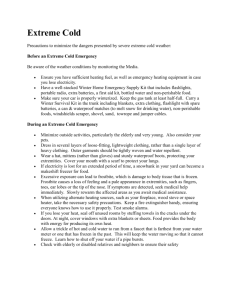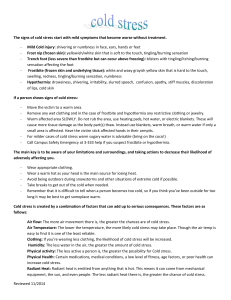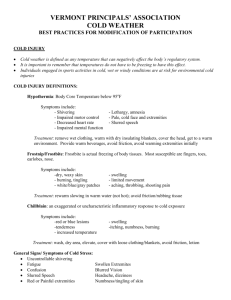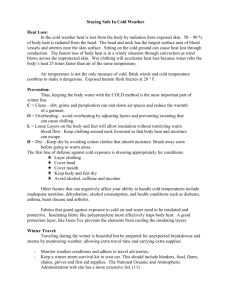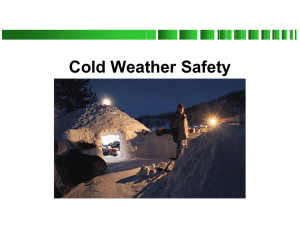Click here for Cold Weather Policy
advertisement
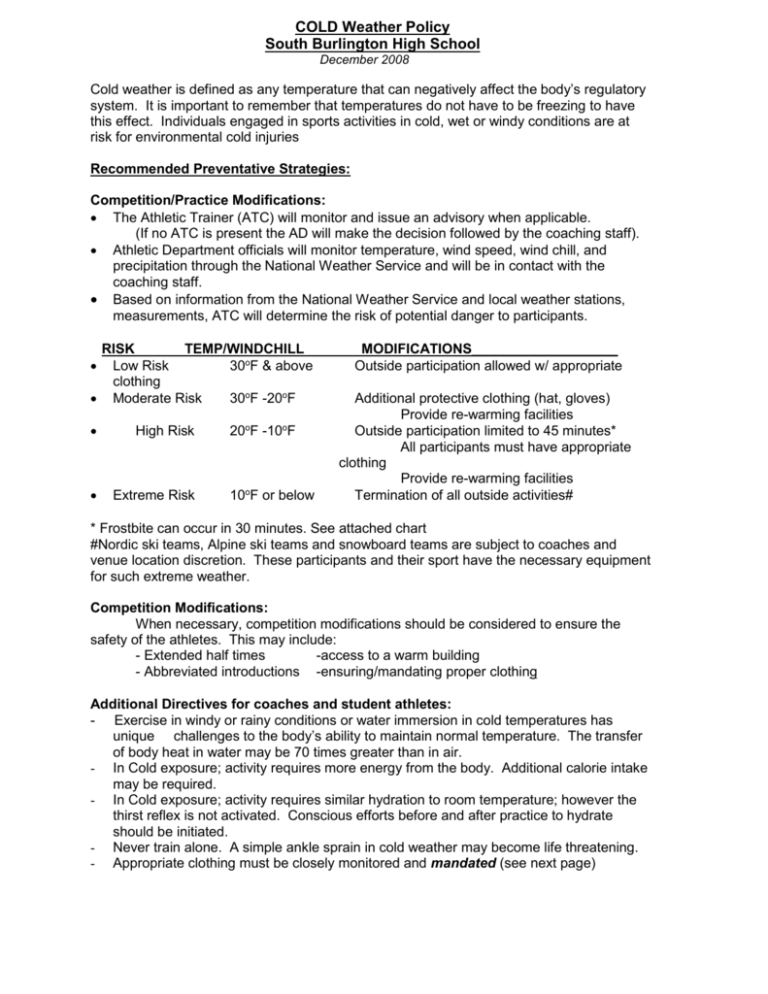
COLD Weather Policy South Burlington High School December 2008 Cold weather is defined as any temperature that can negatively affect the body’s regulatory system. It is important to remember that temperatures do not have to be freezing to have this effect. Individuals engaged in sports activities in cold, wet or windy conditions are at risk for environmental cold injuries Recommended Preventative Strategies: Competition/Practice Modifications: The Athletic Trainer (ATC) will monitor and issue an advisory when applicable. (If no ATC is present the AD will make the decision followed by the coaching staff). Athletic Department officials will monitor temperature, wind speed, wind chill, and precipitation through the National Weather Service and will be in contact with the coaching staff. Based on information from the National Weather Service and local weather stations, measurements, ATC will determine the risk of potential danger to participants. RISK TEMP/WINDCHILL Low Risk 30oF & above clothing Moderate Risk 30oF -20oF High Risk Extreme Risk 20oF -10oF 10oF or below MODIFICATIONS___________________ Outside participation allowed w/ appropriate Additional protective clothing (hat, gloves) Provide re-warming facilities Outside participation limited to 45 minutes* All participants must have appropriate clothing Provide re-warming facilities Termination of all outside activities# * Frostbite can occur in 30 minutes. See attached chart #Nordic ski teams, Alpine ski teams and snowboard teams are subject to coaches and venue location discretion. These participants and their sport have the necessary equipment for such extreme weather. Competition Modifications: When necessary, competition modifications should be considered to ensure the safety of the athletes. This may include: - Extended half times -access to a warm building - Abbreviated introductions -ensuring/mandating proper clothing Additional Directives for coaches and student athletes: - Exercise in windy or rainy conditions or water immersion in cold temperatures has unique challenges to the body’s ability to maintain normal temperature. The transfer of body heat in water may be 70 times greater than in air. - In Cold exposure; activity requires more energy from the body. Additional calorie intake may be required. - In Cold exposure; activity requires similar hydration to room temperature; however the thirst reflex is not activated. Conscious efforts before and after practice to hydrate should be initiated. - Never train alone. A simple ankle sprain in cold weather may become life threatening. - Appropriate clothing must be closely monitored and mandated (see next page) Clothing Guidelines: In cold weather conditions appropriate clothing should be worn to prevent cold exposure. Both the Athletic Trainer(s) and the coaches should mandate the studentathletes to implement the following: Wear several layers around the core of the body (especially those who are not very active). o The first layer should wick moisture away from the body (Dry Tech, Underarmor) o The top layers should trap heat and block the wind (fleece) o The Outer layer should be wind and water-resistant or waterproof o No cotton as inside layer. Long pants designed to insulate. o Sweatpants are a good choice as a base layer o On windy or wet days wind pants or a nylon shell should be worn on the surface layer Long sleeved garment that will break the wind Gloves Hat or helmet to protect the ears (cover/tape ear holes of helmets for wind, cold protection) Face protection Moisture wicking socks -It is important that athletes avoid wearing multiple layers of cotton. When the body sweats the cotton will become dense and permeated with sweat Signs/ Symptoms of Cold Stress: Fatigue Confusion Slurred Speech Red or Painful extremities Dizziness Blurred vision Numbness/tingling of skin Uncontrollable shivering Swollen Extremities Headache COLD INJURY Hypothermia: Body Core Temperature below 95oF Symptoms include: -Shivering -Lethargy, amnesia -Impaired motor control -Pale, cold face and extremities -Decreased heart rate -Slurred speech -Impaired mental function Treatment: Remove wet clothing, warm with dry insulating blankets, cover the head, get to a warm environment. Provide warm beverages, avoid friction, avoid warming extremities initially Frostnip/Frostbite: Frostbite is actual freezing of body tissues. Symptoms include: -Dry, waxy skin -Swelling -Burning, tingling -Limited movement -White/blue/gray patches -Aching, throbbing, shooting pain Treatment: Re-warm slowly in warm water (not hot); avoid friction/rubbing tissue Chilblain: is an exaggerated or uncharacteristic inflammatory response to cold exposure. Symptoms include: -Red or blue lesions -Swelling -Increased temperature -Tenderness -Itching, numbness, burning Treatment: Wash, dry area; elevate, cover with loose clothing/blankets; avoid friction, lotion
